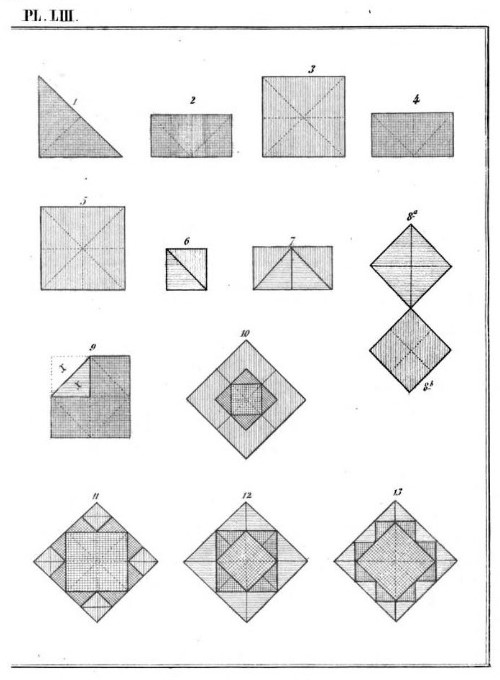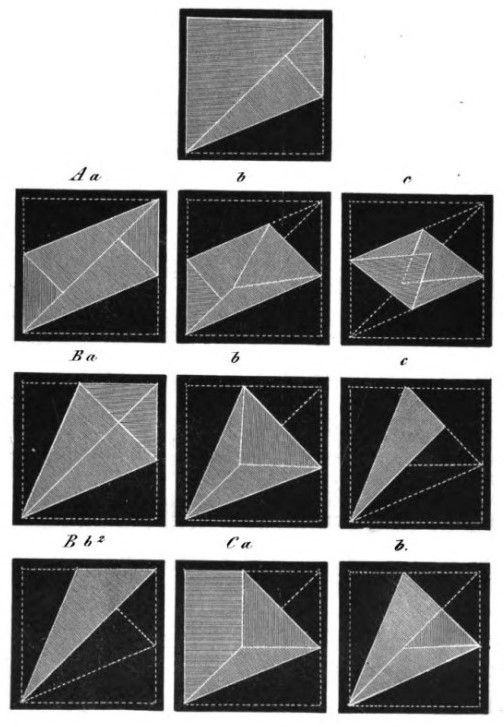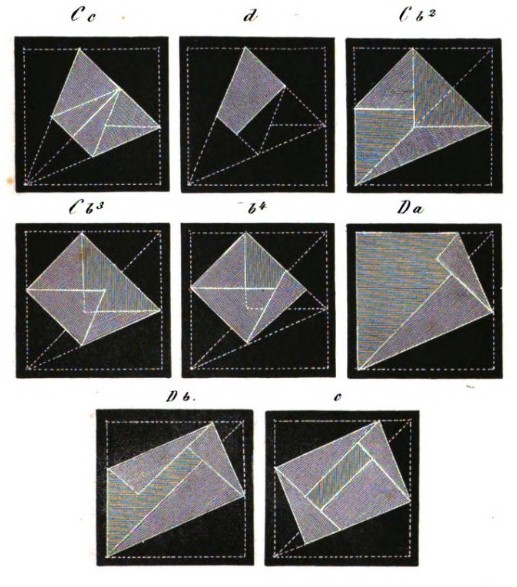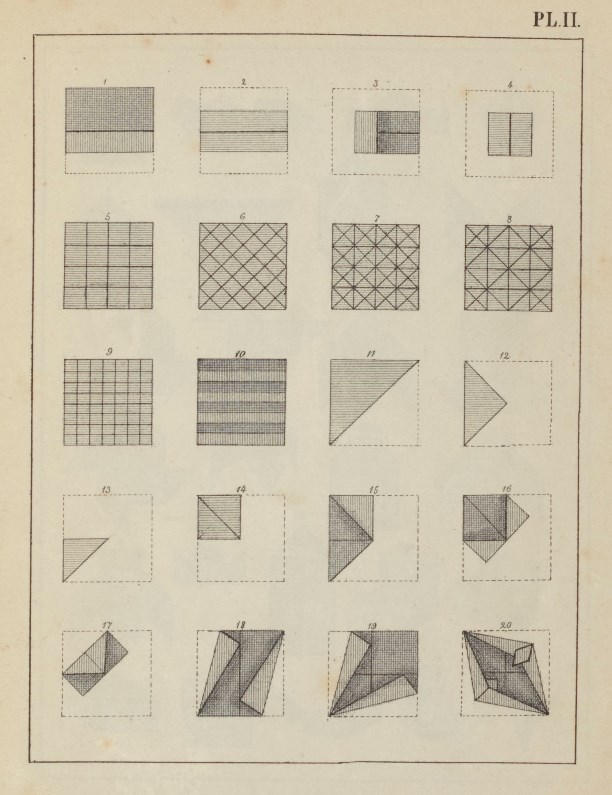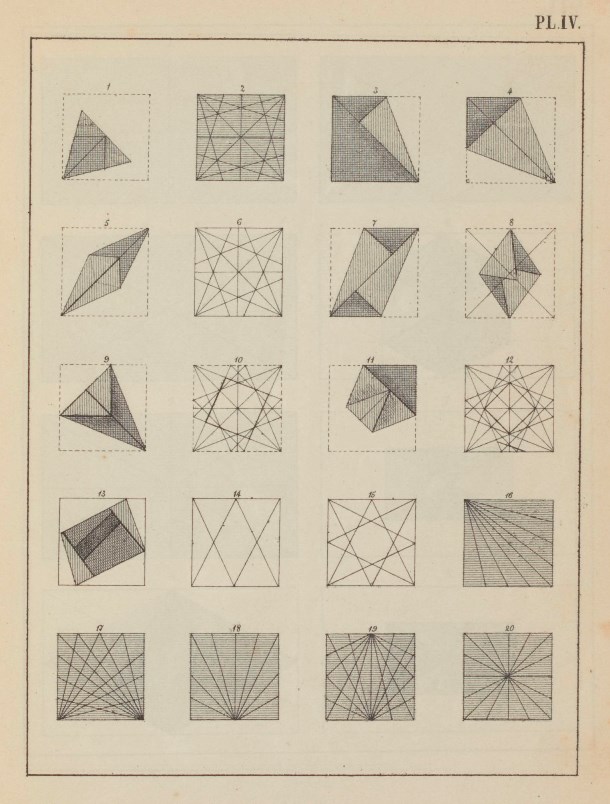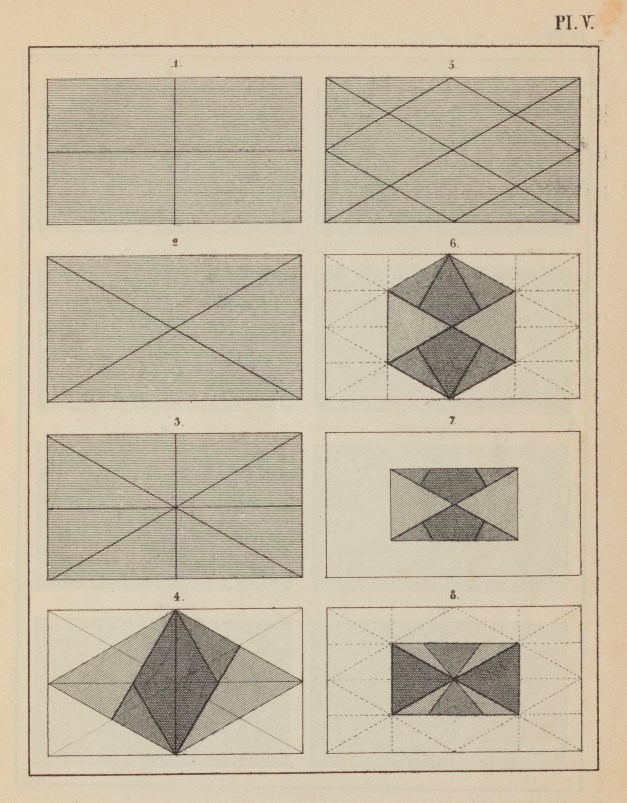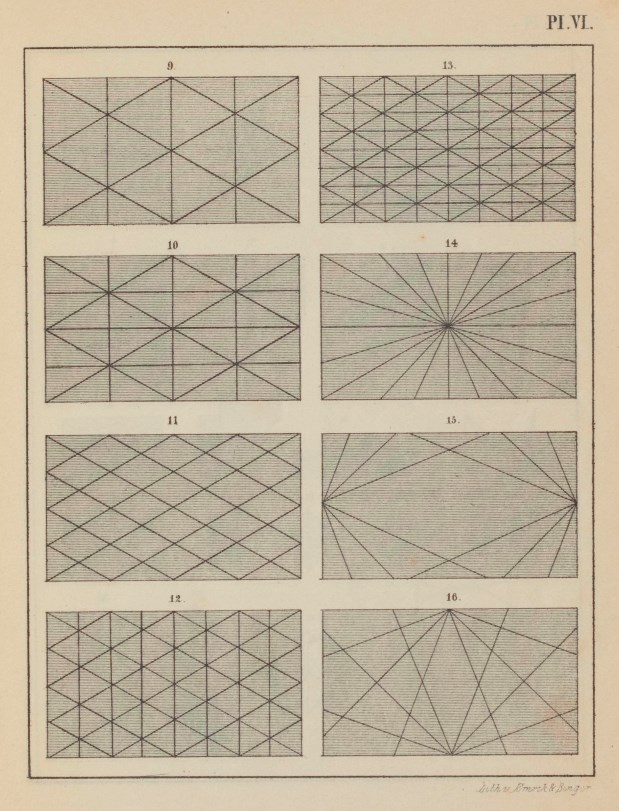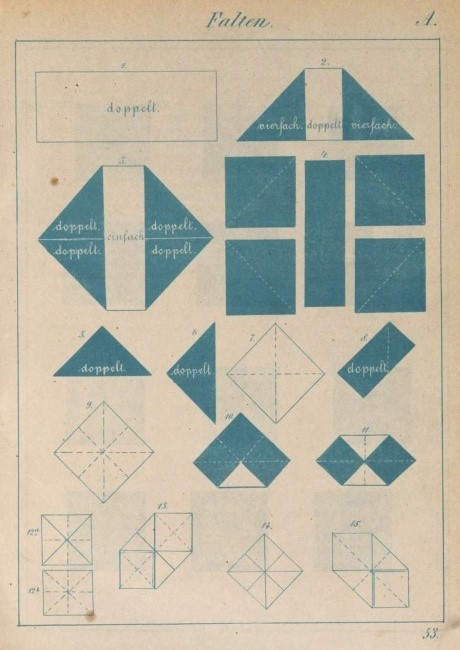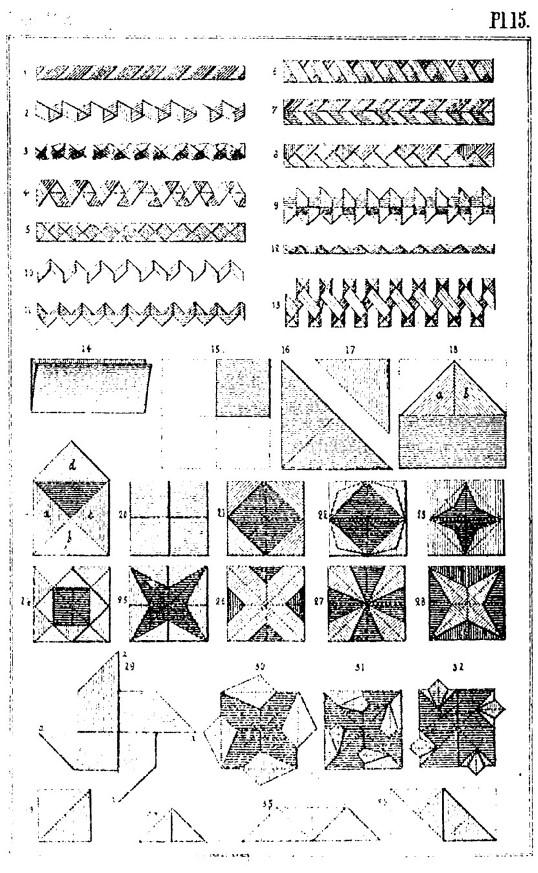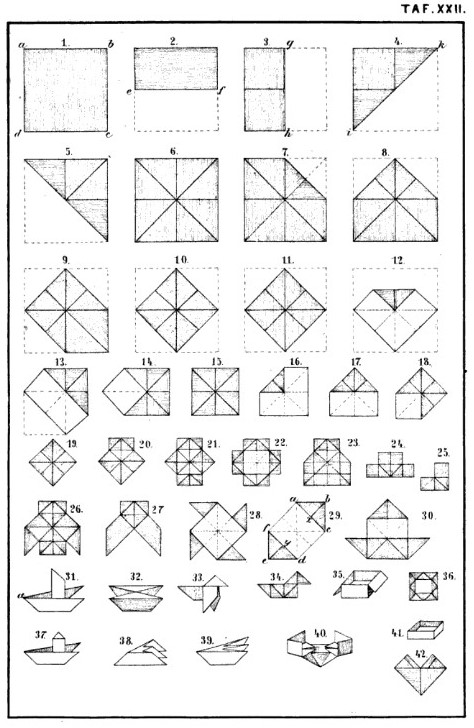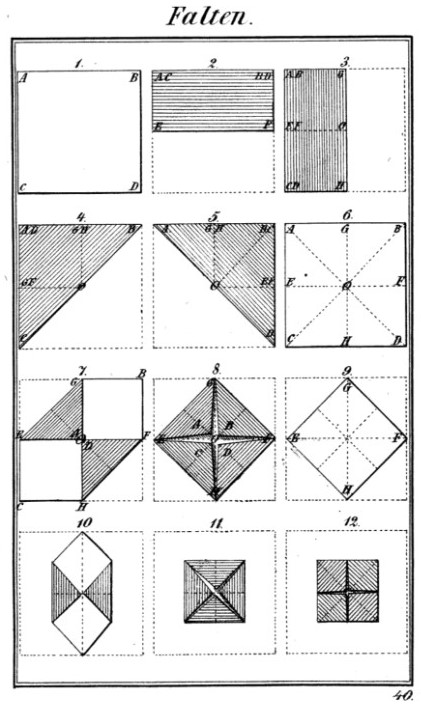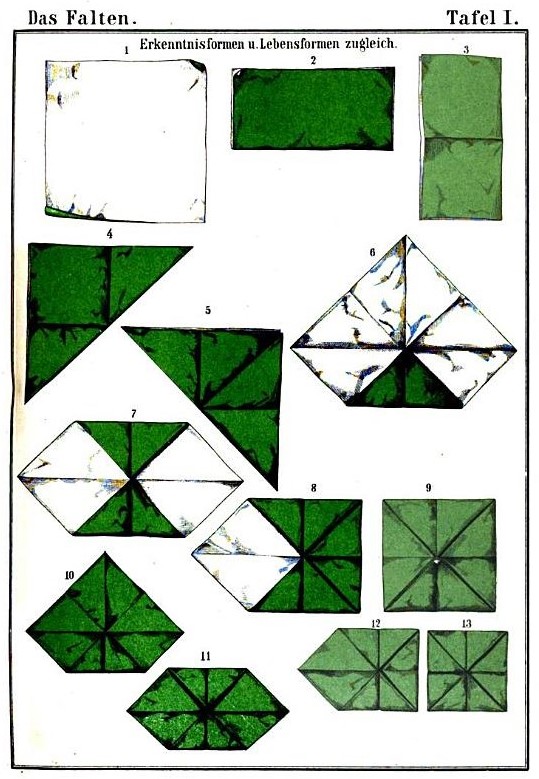| The Public Paperfolding History Project
Last updated 22/12/2023 x |
|||||||
| The Froebelian Occupation of Falten - Erkenntnissformen (Forms of Knowledge) | |||||||
| This
page is being used to collect information about the
Froebelian Occupation of Falten - Erkenntnissformen
(Forms of Knowledge), sometimes also known as Folds of
Truth. Please contact me if you know any of this
information is incorrect or if you have any other
information that should be added. Thank you. Erkenntnissformen were originally simple paperfolds which were intended by Froebel to facilitate basic geometrical understanding but which became progressively more complex in the hands of his followers. Many of the basic geometrical forms were also subsequently given names, usually the names of everyday objects and thus, effectively, became Simple Forms of Life as well as Forms of Knowledge. ********** Prior to 1852 The first description of folded paper Forms of Knowledge appears in 'Die Padagogik des Kindergartens' (The Pedagogy of the Kindergarten), which is a collection of Froebel's writings edited by Wichard Lange and published in 1861. This work was subsequently translated into English by Josephine Jarvis, as 'Friedrich Froebel's Pedagogics of the Kindergarten', and was published by D Appleton and Company in New York in 1895. The translation contains a chapter entitled 'Employment of Children - Guide to Paperfolding - A Fragment' which explains a way to fold and cut a square from an irregular piece of paper and how to then fold that square in a few simple ways to facilitate geometrical understanding. The fragment is undated but must, obviously, have been written prior to Froebel's death in 1852. ********** 1859 Plate LIII of 'Manuel pratique des jardins d'enfants de Frédéric Froebel', which was compiled by J F Jacobs and published by F Claassen in Brussells and L Hachette and Cie in Paris in 1859, shows the development of some basic Forms of Knowledge (pictures 1 to 7), culminating in the development of the Double Blintz Basic Fold (picture 8), which then forms the basis of the Forms of Beauty shown at the foot of the plate.
********** Other information about Folds of Life (though not usually under this heading) appears in: 1861 'Das Paradies der Kindheit' (The Paradise of Childhood) by Lina Morgenstern, which was published in Leipzig in 1861, contains a chapter on Das Papierfalten which briefly refers to 'Erkenntnisformen' (Learning Forms / Forms of Knowledge), which are defined as, roughly, those 'which arise when the square paper is folded into various shapes to form geometrical figures'. No further details or illustrations are provided. ********** 1862 'Das Frobel'sche Faltblatt' (Frobel's Folding Sheet) ) by August Kohler, which was published by Hermann Bohlau in Weimar in 1862, is a guide to the use of a series of paperfolds to teach geometrical ideas in the kindergarten. The main sequence begins with the unfolded square and ends with the Double Blintz Basic Form. The work also extends the range of Froebel's original Folds of Knowledge by showing how the square can be folded into other mathematical shapes, particularly concentrating on shapes that can be achieved by folding edges onto diagonal creases.
**********
********** 1863 'Moral Culture of Infancy and Kindergarten Guide' by Mrs Horace Mann (Mary Tyler Peabody) and Elizabeth P Peabody, which was published by T O H P Burnham in Boston in 1863, contains a section describing how paperfolding can be used to teach some basic mathematical ideas. ********** 'De Kleine Papierwerkers: Volume 1: Wat men van een stukje papier al maken kan: Het vouwen' (What one can make from a piece of paper Folding)' the first in a series of four books about Froebelian occupations written by Elise Van Calcar, was published by K H Schadd in Amsterdam in 1863. It contains several plates showing Folds of Knowledge. Plate 1 illustrates some basic Forms of Knowledge, culminating in the Double Blintz Basic Form. Plate 2 is the first illustration I know of to show the folding of the Double Bookfold basic Form (pictures 1 to 4). It is also the first illustration I know of to show how angles of 60 and 120 degrees can be obtained from a square by folding.
Plate 4 is the first illustration to show how to construct an equilateral triangle from a square by folding (picture 1).
Plates 5 and 6 extends the range of Folds of Knowledge to include oblongs, and shows, among other things, how a diamond and a regular hexagon can be constructed by folding a bronze rectangle (pictures 4 and 6).
**********
********** 1869 'Der Kindergarten' by Hermann Goldammer, which was published by Habel in Berlin in 1869, explains a few simple geometrical paperfolds.
********** The second edition of 'Moral Culture of Infancy and Kindergarten Guide' by Mrs Horace Mann (Mary Tyler Peabody) and Elizabeth P Peabody, which was published by J W Schemerhorn and Co in New York in 1869, contains a section explaining how to use simple Forms of Knowledge to teach basic geometry. It is similar to, but not the same as, the corrrsponding section in the original 1863 edition. ********** 1873 'Exercices et Travaux pour les Enfants Selon la Méthode et les Procédés de Pestalozzi et de Froebel' by Fanny and Charles Delon, which was published by Librairie Hachette in Paris in 1873, gives some brief examples of geometrical paperfolds (See 14 to 17 and 33 to 36 of Plate 15 below), three of which are given names. Picture 18. La forme du pignon d'une maison (The shape of a gable of a house). 19. Une enveloppe ouverte (An open envelope). The text says that folding in the fourth corner produces the lettre close (closed letter). As far as I know this is the first appearance of non-mathematical names for Forms of Knowledge.
********** 'Die Praxis Des Kindergartens' by Auguste Koehler was published by Herman Bohlau in Weimar in 1873 also contains explanations of some basic geometrical forms, leading in this case to the construction of the Triple blintz Basic Form. The author gives names to some of these forms, thus treating them to some extent as Forms of Life.
********** 1874 The third edition of 'Der Kindergarten' by Hermann Goldammer, which was published by Carl Babel in Berlin in 1874. In this case the sequence of folds only goes as far as the Double Blintz Basic Form. The introduction to the Lebensformen section states, roughly, 'Any change that is made to the square in order to obtain one of the basic forms can give rise to comparisons. If the square is folded in the centre (ie edge to edge) it represents a picture, a roof, a gutter. If it is folded diagonally then it is a handkerchief, a sail, a bag. If you fold the four corners to the centre it becomes a letter, and so on. In this way forms of life are already achieved through the simplest changes.'
********* 1880 'The Kindergarten Principle' by Mary J Lyschinska, which was published in London in 1880 by Wm Isbister Ltd contains a small section devoted to Forms of Knowledge under the name of 'Geometrical and Numerical Exercises'. ********** 1882 Pages 284 to 296 of 'The Kindergarten Guide' by Maria Kraus Boelte and John Kraus, which was first published in single volume form by E. Steiger and Company in New York in 1882, specifically explain how to develop Forms of Knowledge from squares. However there are also references to other Forms of Knowlege (whether named as such or not) made from squares, oblongs and equilateral triangles throughout the chapter. Many of these forms are given the names of common objects and so also treated as Forms of Life. The book also shows how to take some of these simple geometrical forms and use them as tiles to produce compound forms. ********** 1887 Some basic Erkenntnissformen (Forms of Knowledge) culminating in the doubly blintzed basic form, appear in part 2 'Die Praxis' of 'Theoretisches und praktisches Handbuch der Fröbelschen Erziehungslehre' by Bertha von Marentholtz-Bülow, which was published by George H Wigand in Kassel in 1887.
********** 1895 Plates V and VI of Eleonore Heerwart's 'Course in Paperfolding', which was first published in Dutch in 1895 then in English by Charles and Dible in London and Glasgow in 1896, illustrate Forms of Knowledge. ********** |
|||||||
